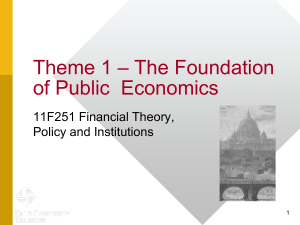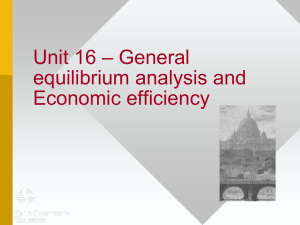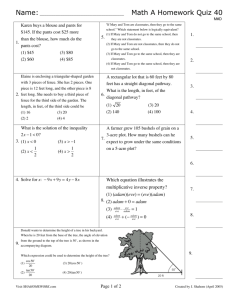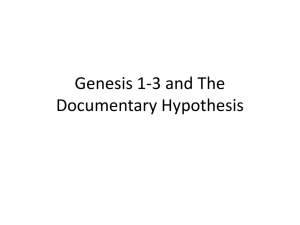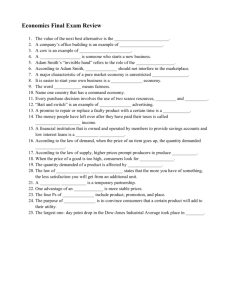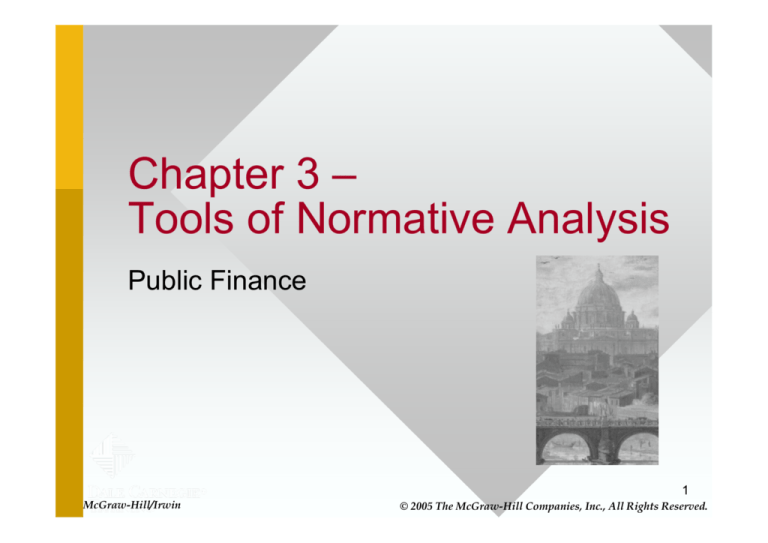
Chapter 3 –
Tools of Normative Analysis
Public Finance
1
McGraw-Hill/Irwin
© 2005 The McGraw-Hill Companies, Inc., All Rights Reserved.
Welfare Economics
• Need systematic framework to assess the desirability of
various government actions.
• Welfare economics is concerned with the social
desirability of alternative economic states.
– Distinguishes cases when private markets work well from
cases where government intervention may be warranted.
• Relies heavily on basic microeconomic tools, particularly
indifference curves.
2
Pure Exchange Economy
• Economy with
– 2 people (Adam & Eve)
– 2 commodities (Apples & Figs)
– Fixed supply of commodities (e.g., on a desert island)
• An Edgeworth Box depicts the distribution of goods
between the two people.
3
Figure 3.1
Pure Exchange Economy
• Each point in the box in Figure 3.1 represents an allocation
between Adam and Eve.
– Each point in the box fully exhausts the resources on the
island. Adam consumes what Eve doesn’t.
– Adam’s consumption of apples and figs increases as we
move toward the northeast in the box.
– Eve’s consumption of apples and figs increases as we move
toward the southwest in the box.
• At point v in the figure, Adam’s allocation of apples is Ox,
and of figs is Ou. Eve consumes O’v of apples, and O’w of
figs.
5
Pure Exchange Economy
• Assume that Adam and Eve each have conventionally
shaped indifference curves.
• Adam’s happiness increases as he consumes more;
therefore, his utility is higher for bundles toward the
northeast in the Edgeworth Box.
– We can therefore draw “standard” indifference curves for
Adam in this picture. Adam would get even higher utility by
moving further to the northeast, outside of the Edgeworth Box,
but he is constrained by the resources on the island.
6
Pure Exchange Economy
• Similarly, Eve’s happiness increases as she consumes
more; therefore, her utility is higher for bundles toward the
southwest in the Edgeworth Box.
– Eve’s indifference curves therefore are “flipped around.” Her
utility is higher on E3 compared E2 or E1.
7
Figure 3.2
Pure Exchange Economy
• Suppose some arbitrary point in the Edgeworth Box is
selected, for example, point g in Figure 3.3.
• This provides an initial allocation of goods to Adam and Eve
and, thus, some initial level of utility.
9
Figure 3.3
Pure Exchange Economy
• We can now pose the following question: Is it possible to
reallocate apples and figs between Adam and Eve to make
Adam better off, while Eve is made no worse off?
• Allocation h in Figure 3.3 is one possibility. We are “moving
along” Eve’s indifference curve, so her utility remains
unchanged. Adam’s utility clearly increases.
• Clearly, other allocations achieve this same goal, such as
allocation p.
• Once we reach allocation p, we cannot raise Adam’s utility
any more, while keeping Eve’s utility unchanged.
11
Pure Exchange Economy
• An allocation is Pareto efficient if the only way to make
one person better off is to make another person worse off.
– Often used as the standard for evaluating desirability of an
allocation of resources.
– Pareto inefficient allocations are wasteful.
• A Pareto improvement is a reallocation of resources that
makes one person better off without making anyone else
worse off.
12
Figure 3.4
Pure Exchange Economy
• Many allocations are Pareto efficient. Figure 3.5 illustrates
three of them -- allocations p, p1 and p2.
– Among these Pareto efficient allocations, some provide Adam
with higher utility than others, and the opposite ones provide
Eve with higher utility.
14
Figure 3.5
Pure Exchange Economy
• In fact, there are a whole set of Pareto efficient points in the
Edgeworth Box.
• The locus of all the set of Pareto efficient points is called
the contract curve.
• Figure 3.7 illustrates the contract curve.
16
Figure 3.7
Pure Exchange Economy
• Figure 3.7 shows that each of the Pareto efficient points is
where an indifference curve of Adam is tangent to an
indifference curve of Eve.
• Mathematically, the slopes of Adam’s and Eve’s
indifference curves are equal.
• The (absolute value of) slope of the indifference curve
indicates the rate at which the individual is willing to trade
one good for another, know as the marginal rate of
substitution (MRS).
18
Pure Exchange Economy
• Pareto efficiency requires:
MRS
Adam
af
= MRS
Eve
af
19
Production Economy
• In pure exchange economy, assumed supplies of
commodities were fixed.
• Now consider scenario where quantities can change.
• The production possibilities curve shows the maximum
quantity of figs that can produced with any given quantity of
apples.
20
Figure 3.8
Production Economy
• For apple production to be increased, fig production must
necessarily fall.
• The marginal rate of transformation (MRT) of apples for
figs (MRTaf) shows the rate at which the economy can
transform apples to fig leafs.
– It is the absolute value of the slope of the production
possibilities curve.
• The marginal rate of transformation can be written in terms
of marginal costs:
MCa
MRTaf =
MC f
22
Efficiency with Variable Production
• With variable production, efficiency requires:
MRTaf = MRS
Adam
af
= MRS
Eve
af
• If this were not the case, it is possible to make one person
better off with an adjustment production. Rewriting in terms of
marginal costs, we then have:
MCa
Adam
Eve
= MRS af = MRS af
MC f
23
First Fundamental Theorem of
Welfare Economics
• Assume that
– All producers and consumers act as perfect competitors (e.g.,
no market power)
– A market exists for each and every commodity
• Under these assumptions, the first fundamental theorem
of welfare economics states that a Pareto efficient
allocation will emerge.
• Implication: Competitive economy automatically allocates
resources efficiently, without central planning.
• Conclusion: Free enterprise systems are amazingly
productive.
24
Second Fundamental Theorem of
Welfare Economics
• Note that Pareto efficiency (and the first fundamental
welfare theorem) does not mean fairness.
– Either the northeast or southwest corner of the Edgeworth
Box is Pareto efficient, but very unequal distribution.
• Society may care about more than Pareto efficiency.
• From the contract curve in the Edgeworth Box, could map
or derive the relationship between Adam’s and Eve’s
utilities, on the utilities possibilities curve.
25
Figure 3.10
Second Fundamental Theorem of
Welfare Economics
•
The frontier of the utilities possibilities curve is, by definition,
attainable. Similar to a budget constraint.
•
Could postulate a social welfare function, which embodies
society’s views on the relative well-being of Adam and Eve:
W = F (U Adam , U Eve )
•
Could then maximize society’s preferences, or demonstrate that
some Pareto-inefficient bundles are preferred to some Paretoefficient ones.
27
Figure 3.12
Second Fundamental Theorem of
Welfare Economics
• The second fundamental theorem of welfare economics
states that society can attain any Pareto-efficient allocation
of resources by making a suitable assignment of initial
endowments and then allowing free trade.
• No adjustments to prices.
• Issues of efficiency and distributional fairness can be
separated.
29
Market Failure
• Theorems will be violated when there are market failures
– Market power (monopoly)
– Nonexistence of markets
• Information failures (asymmetric information)
• Externalities
• Public goods
30
Evaluating Policy
• Will the policy have desirable distributional consequences?
• Will it enhance efficiency?
• Can it be done at a reasonable cost?
31
Recap of Tools of
Normative Analysis
• What is welfare economics
• Pure exchange economy
• Production economy
• First and second fundamental welfare theorems
32

